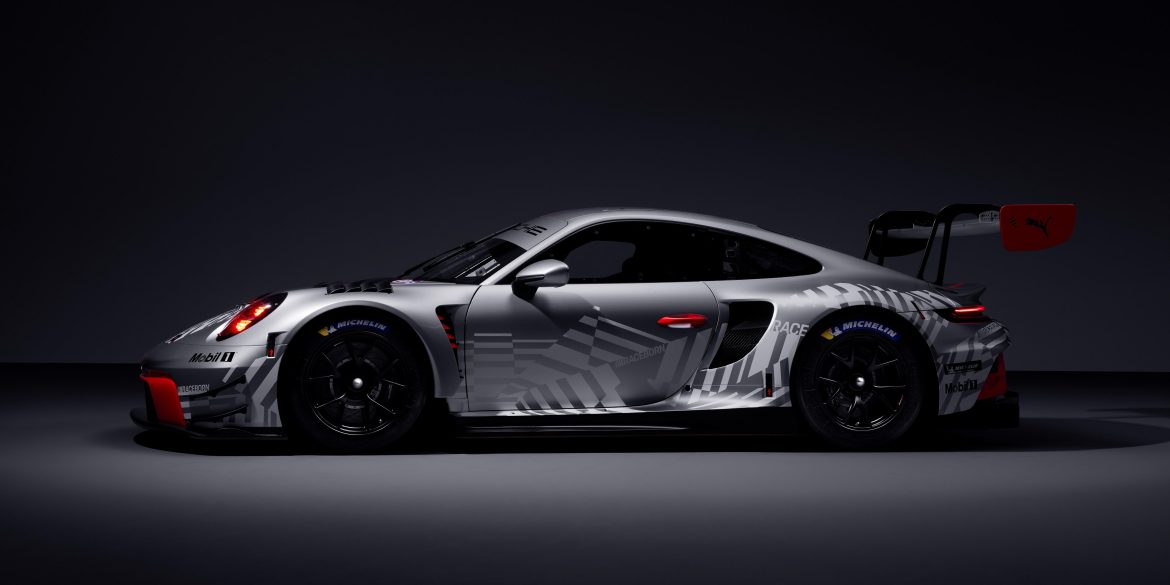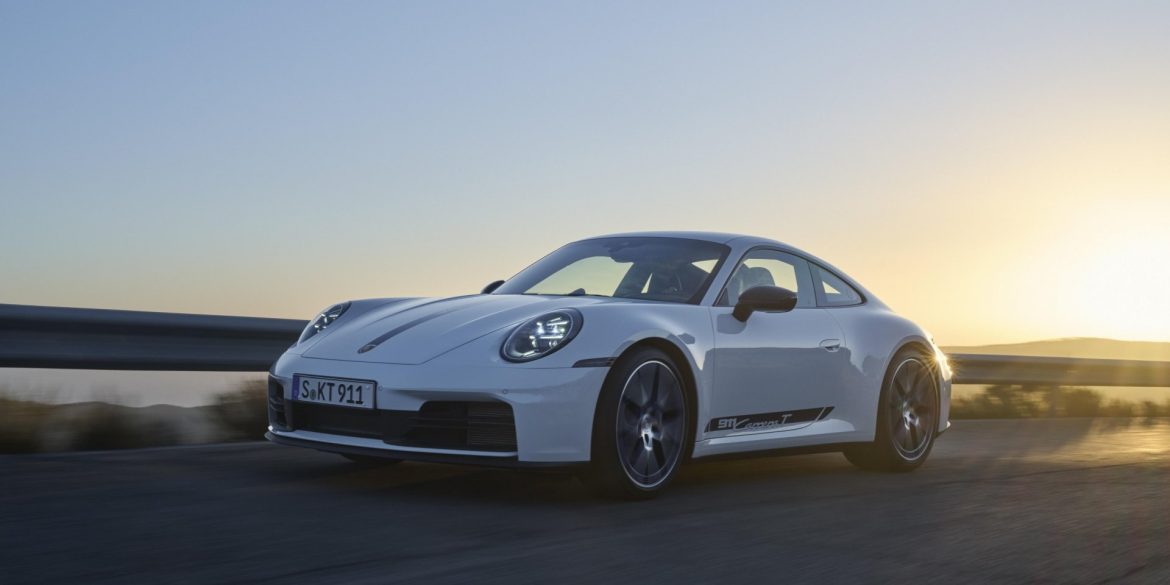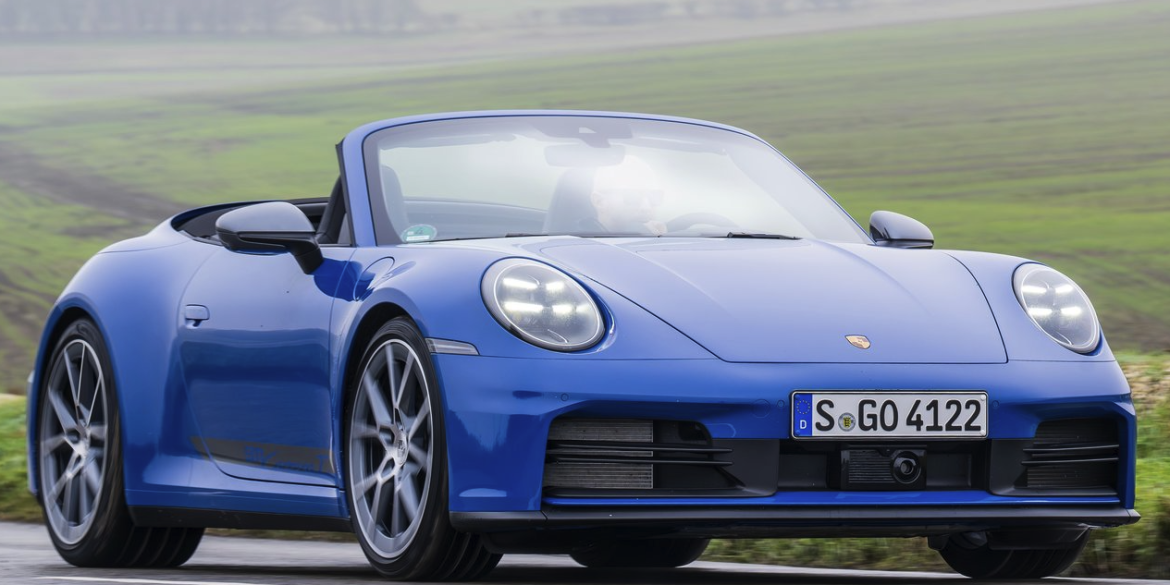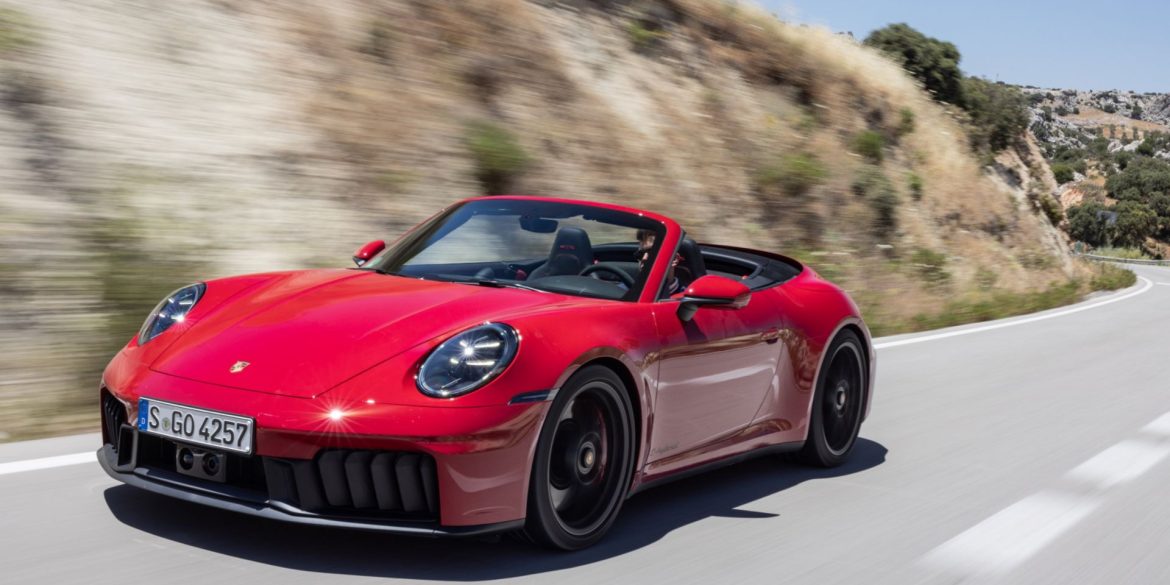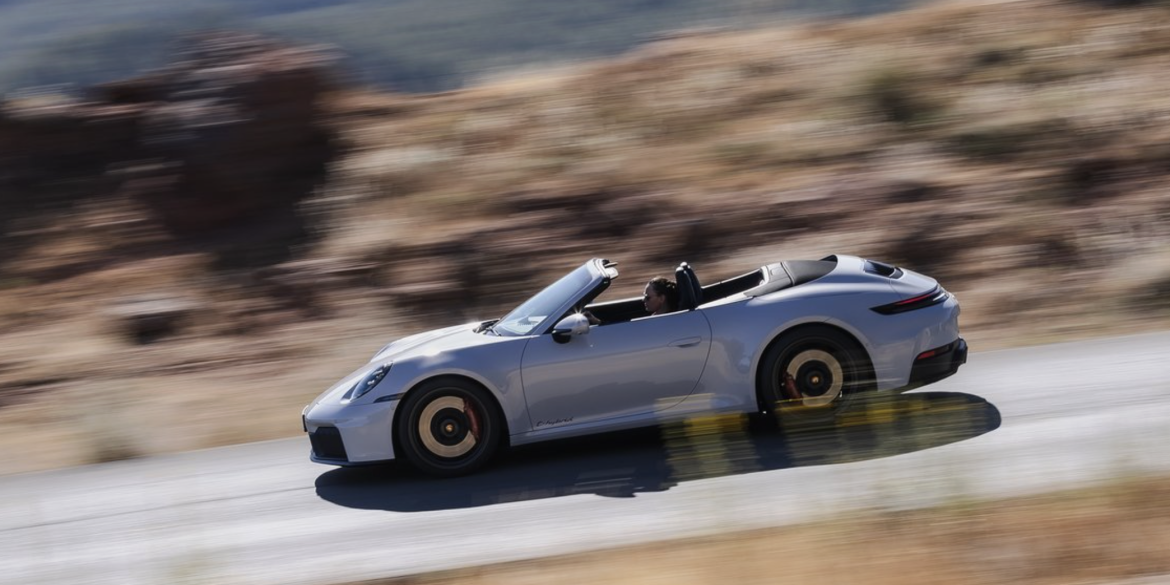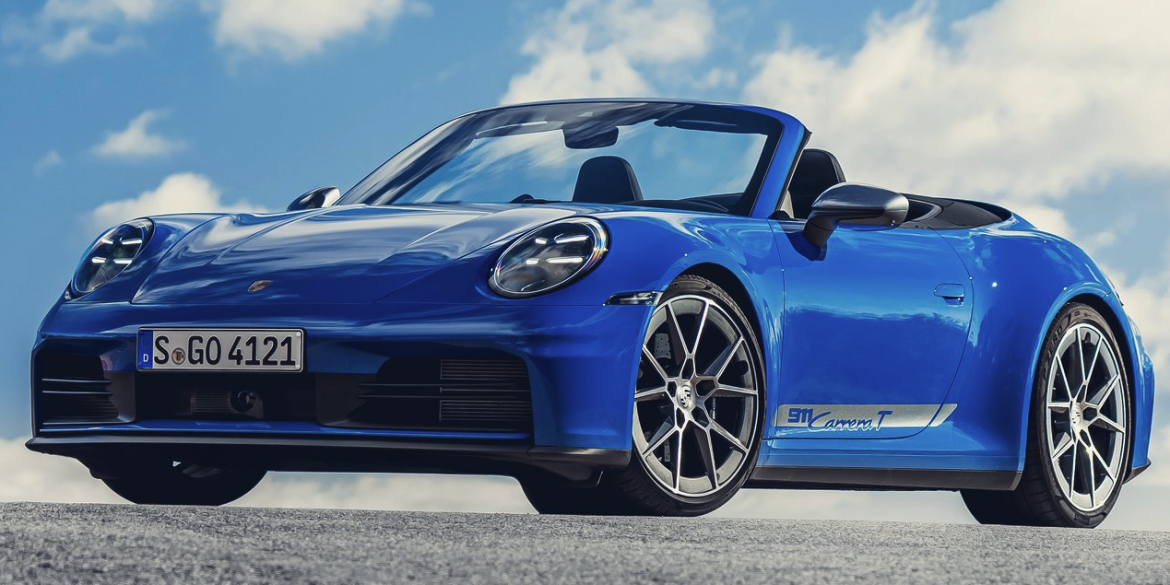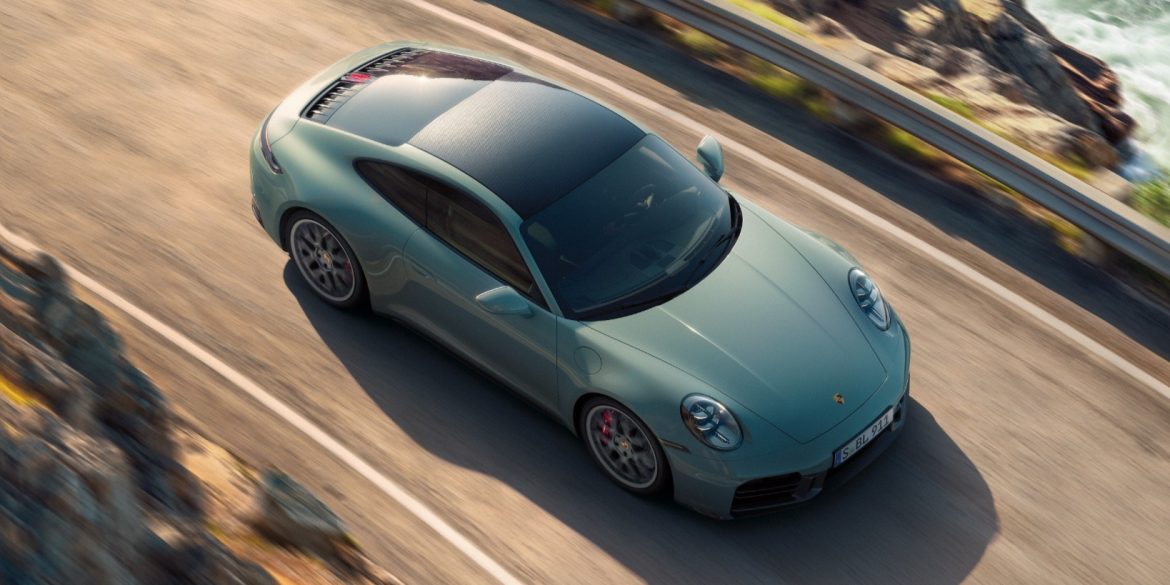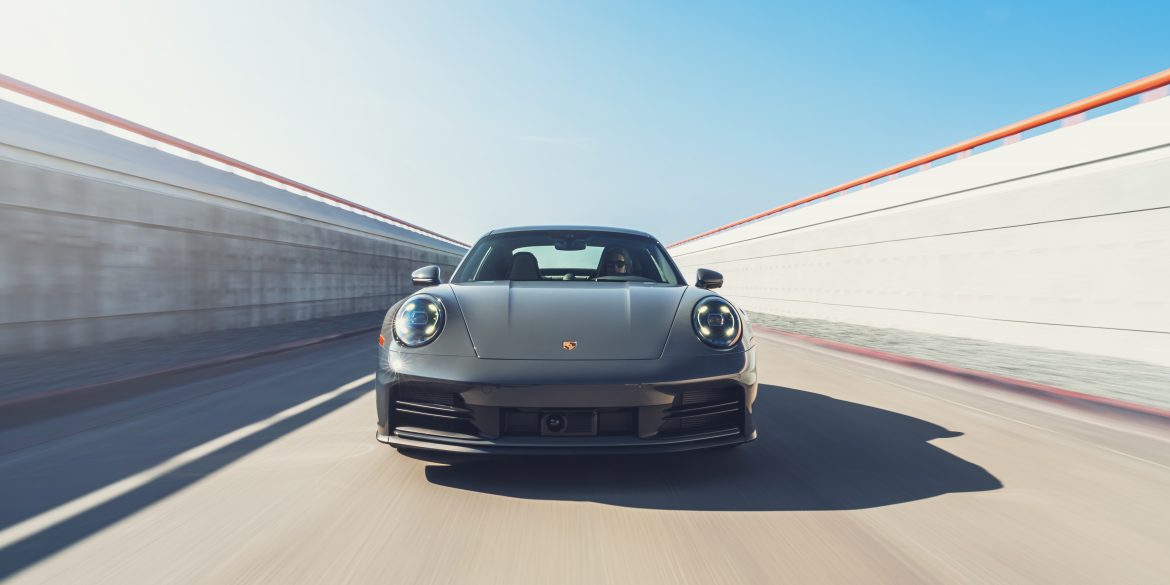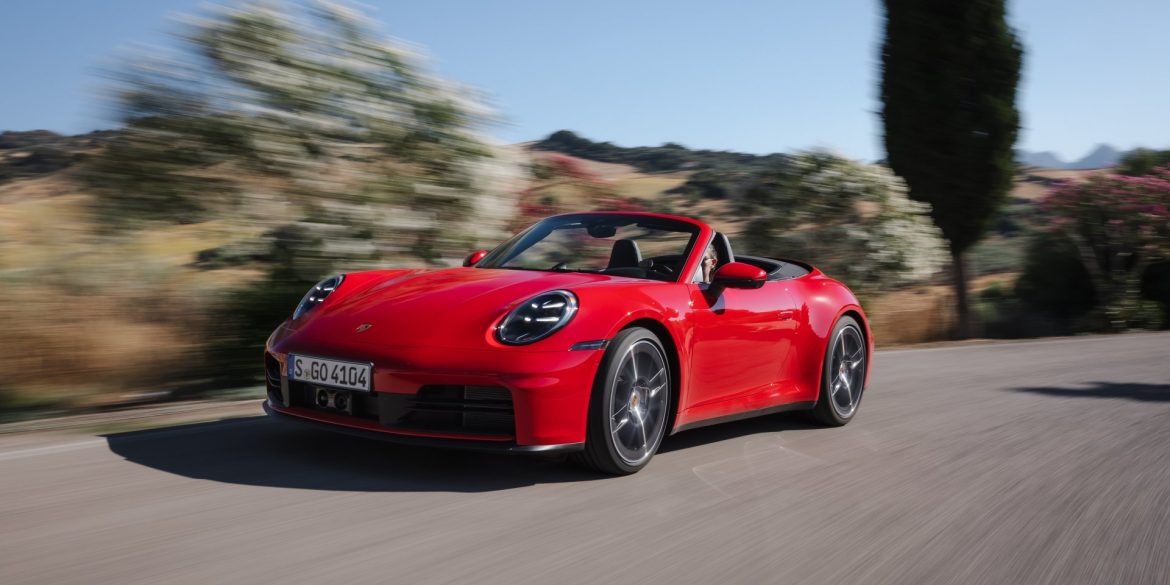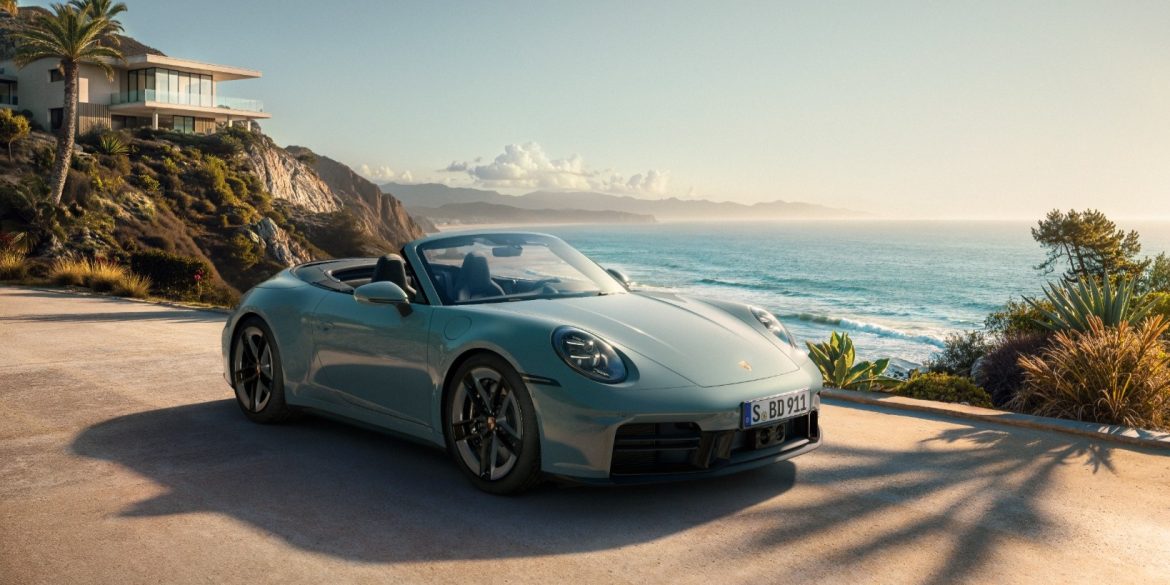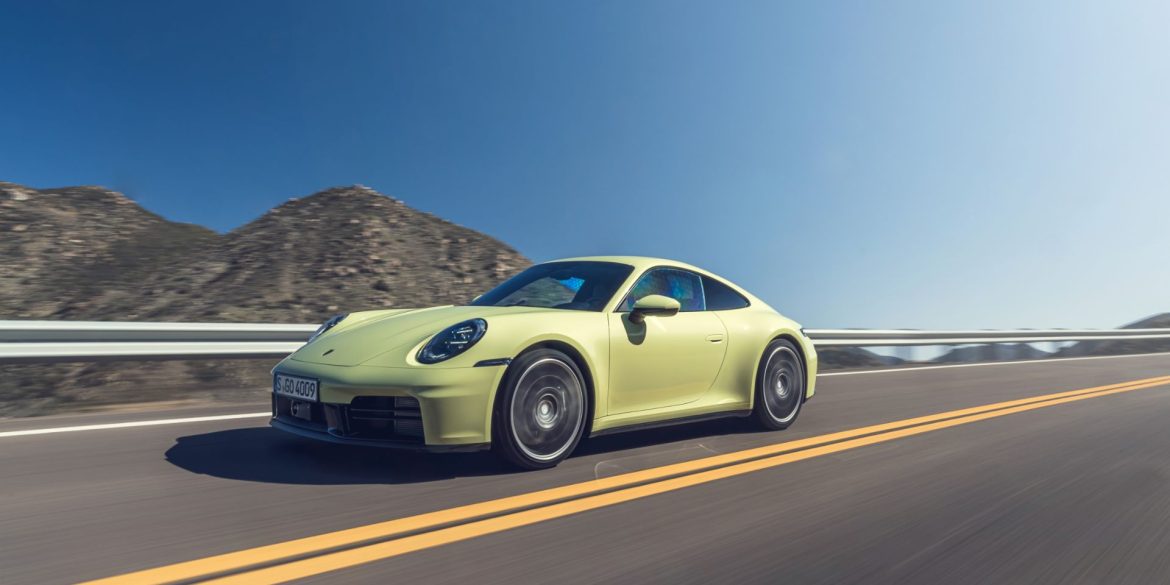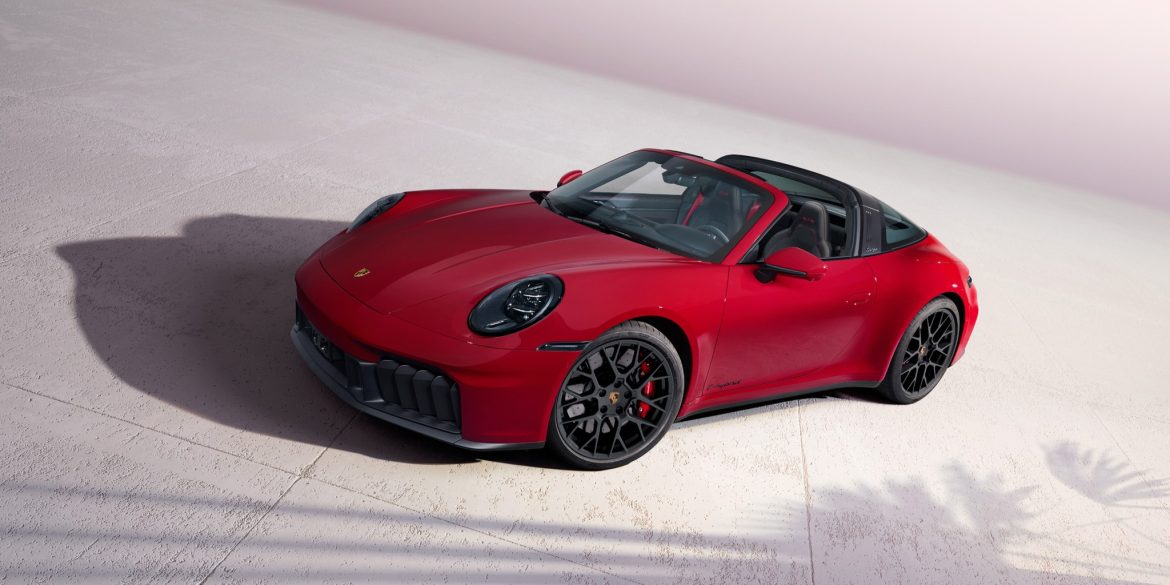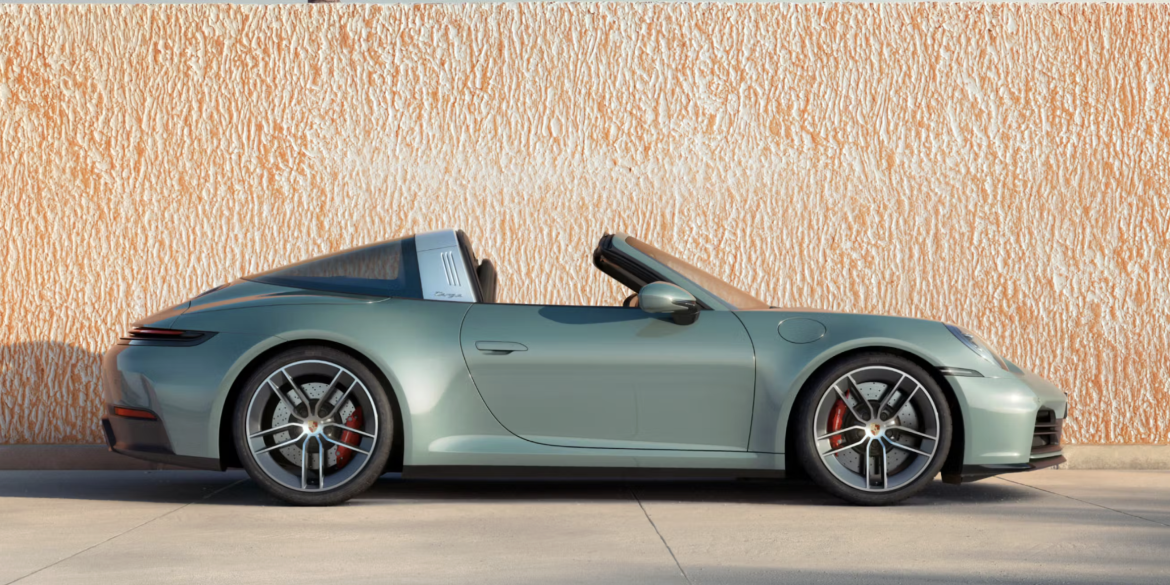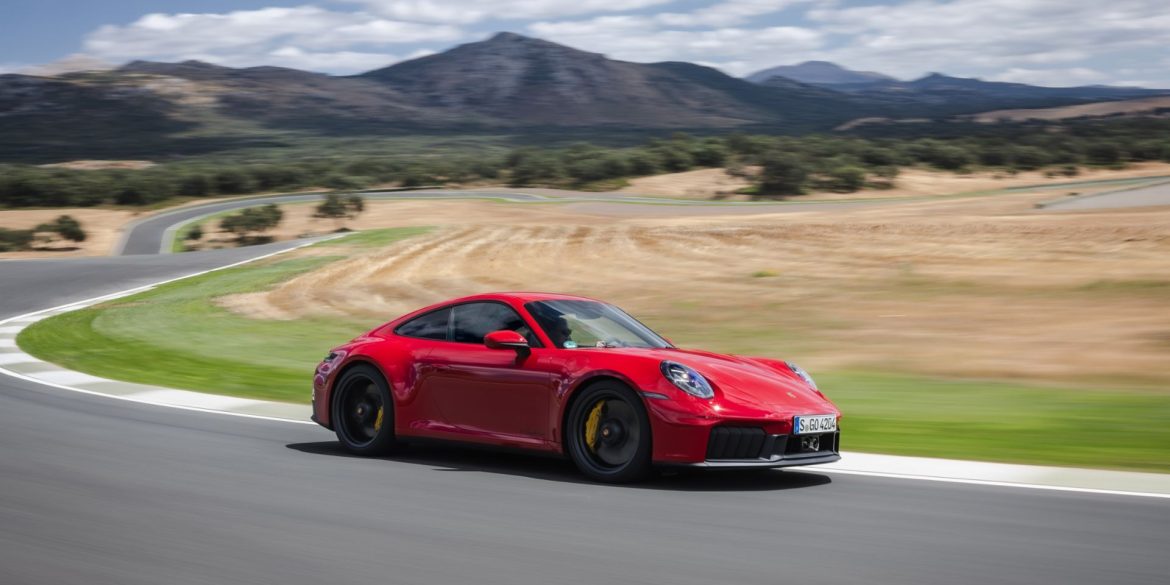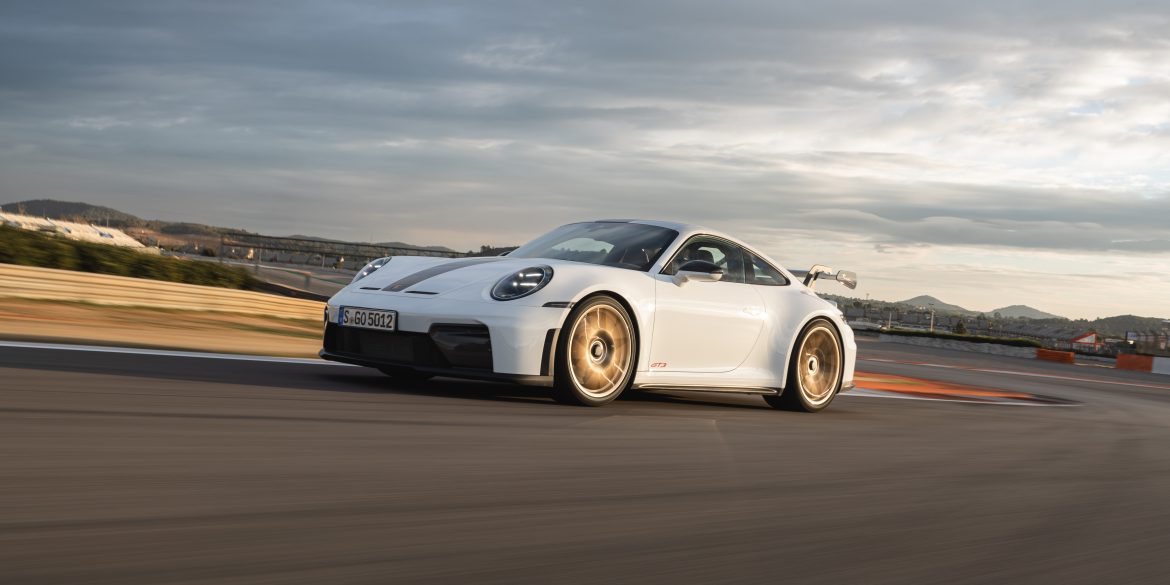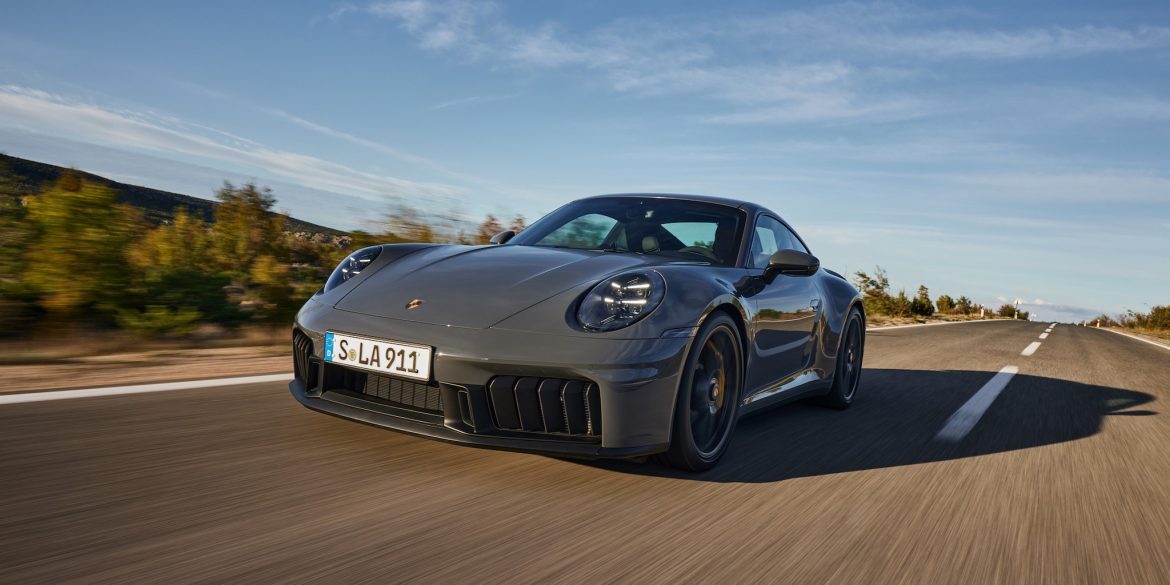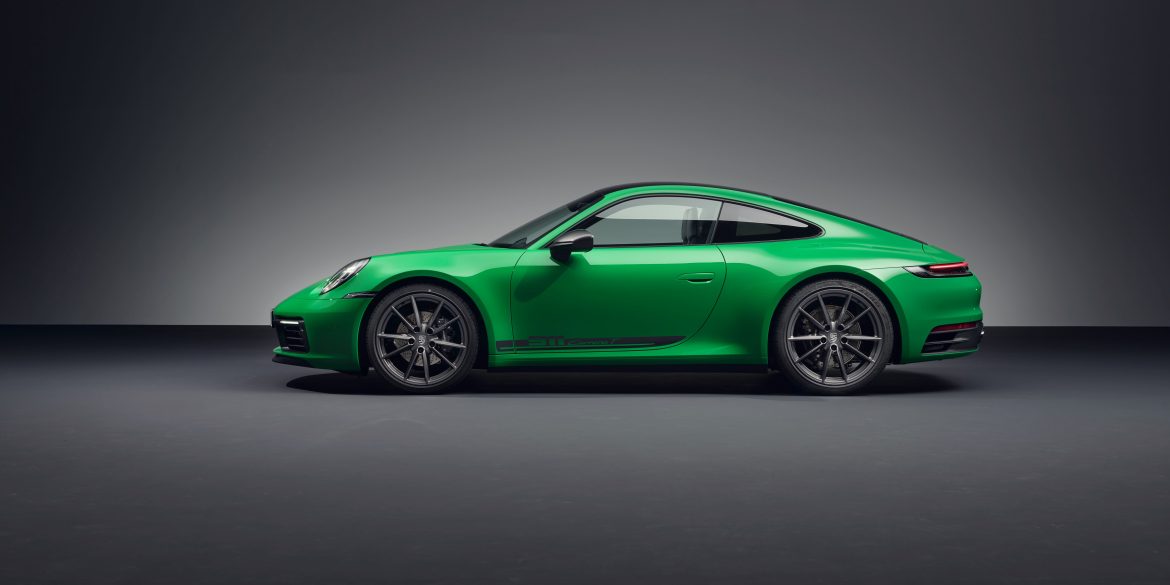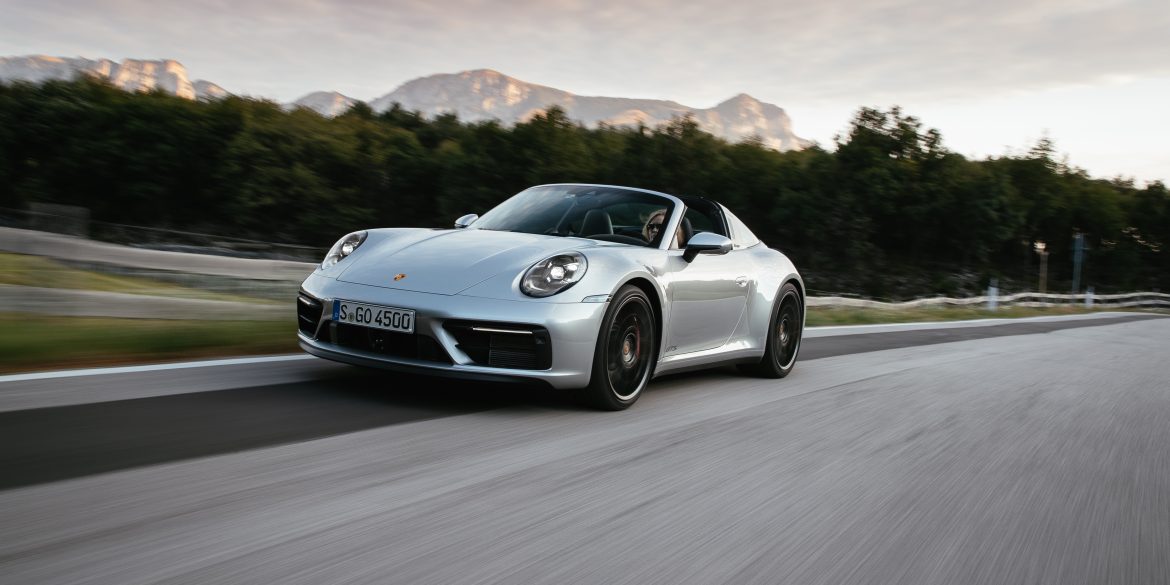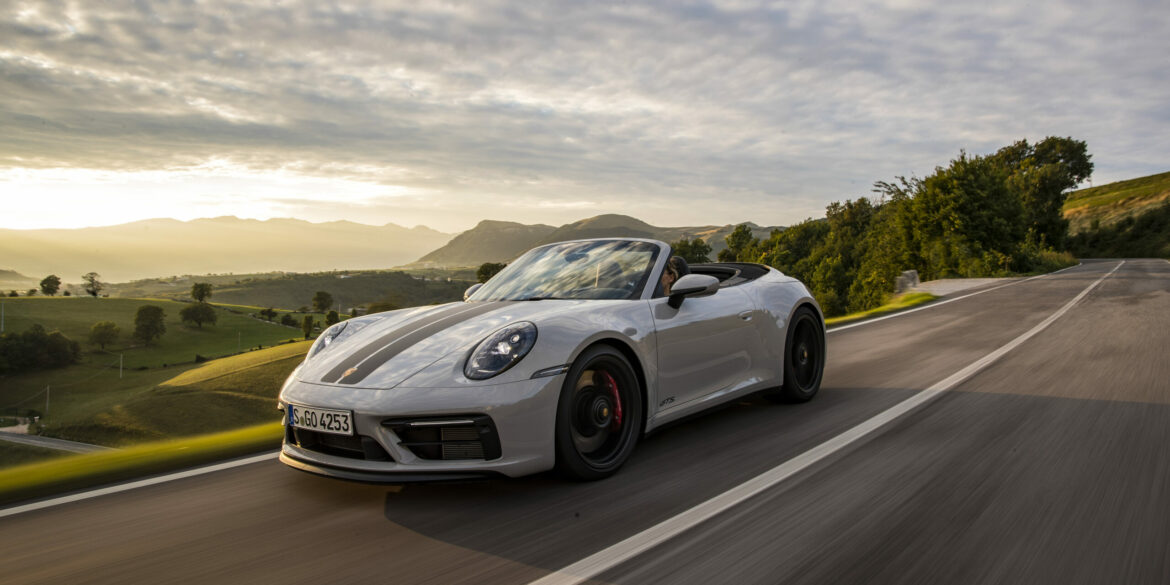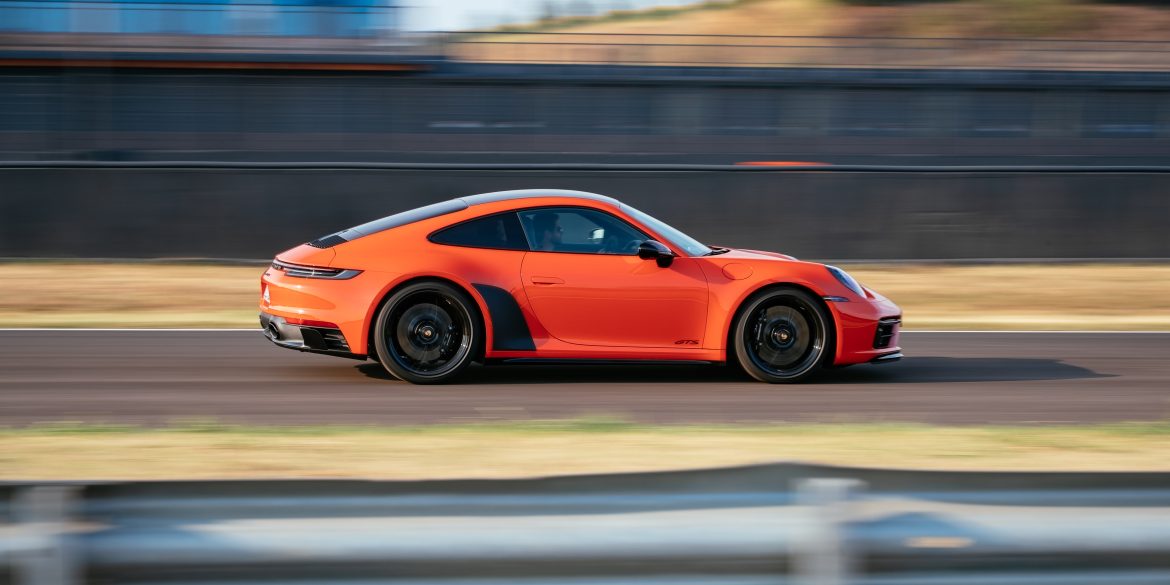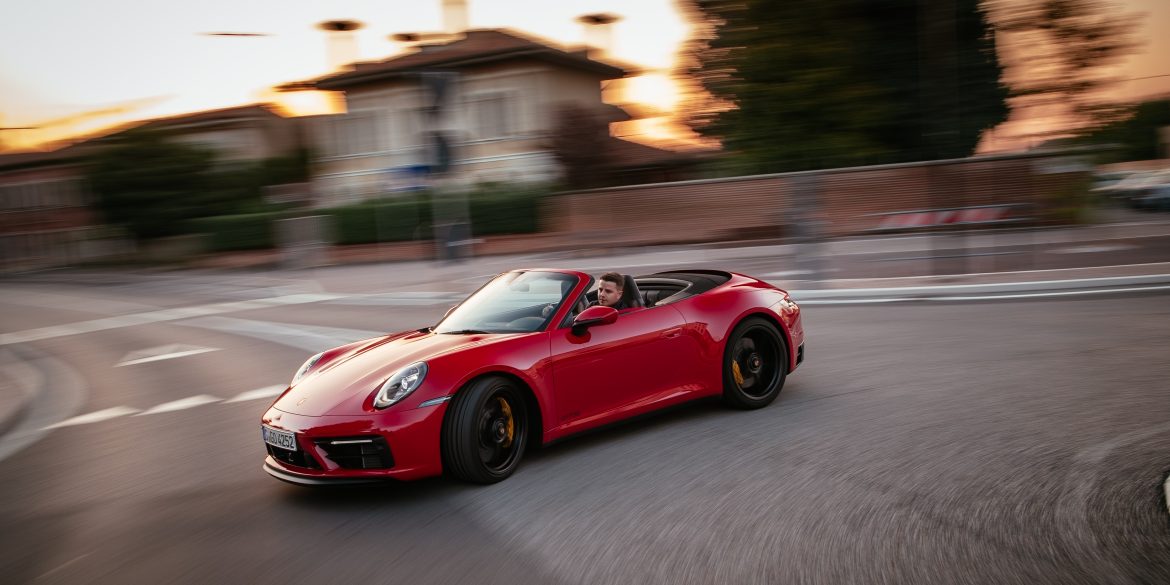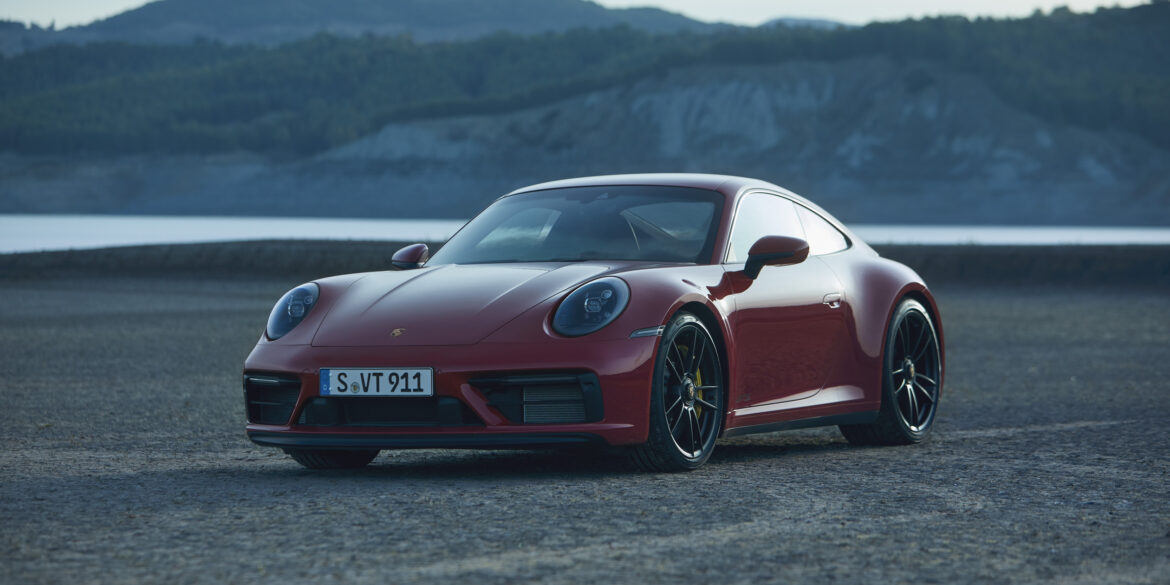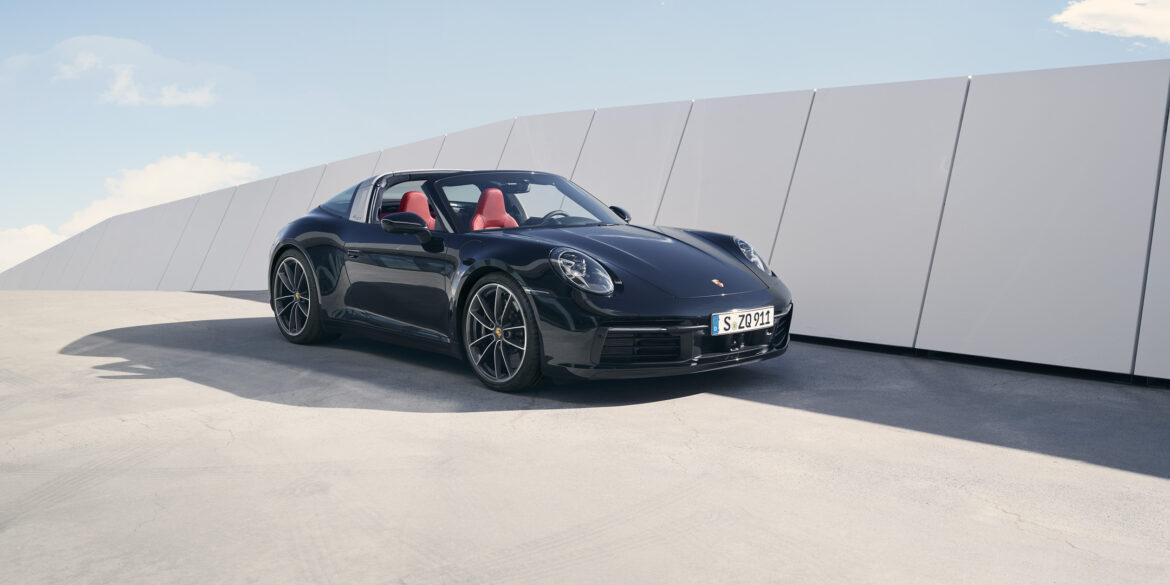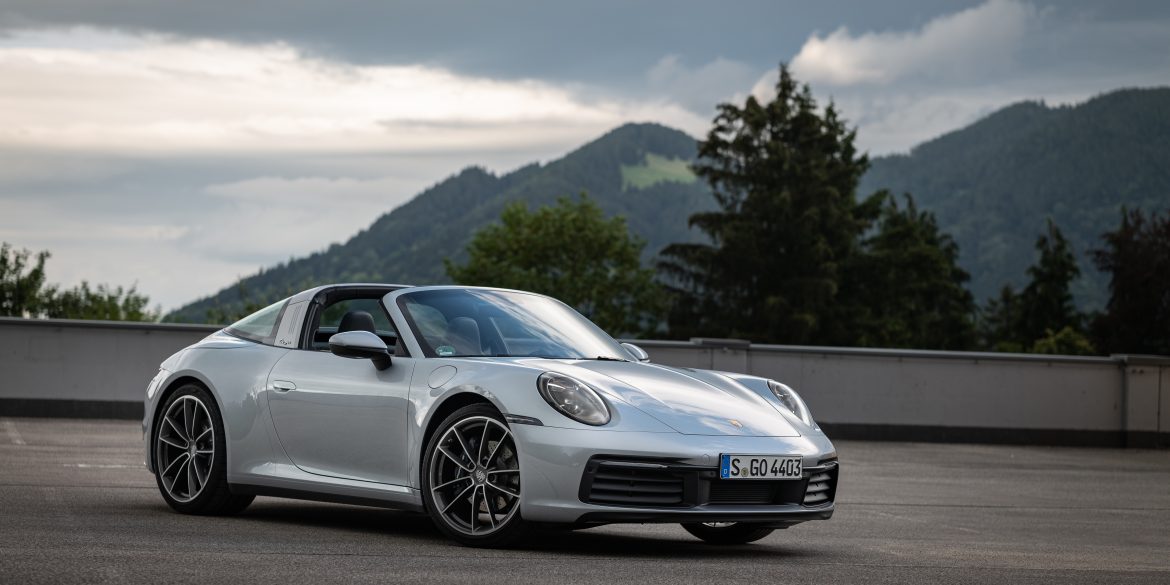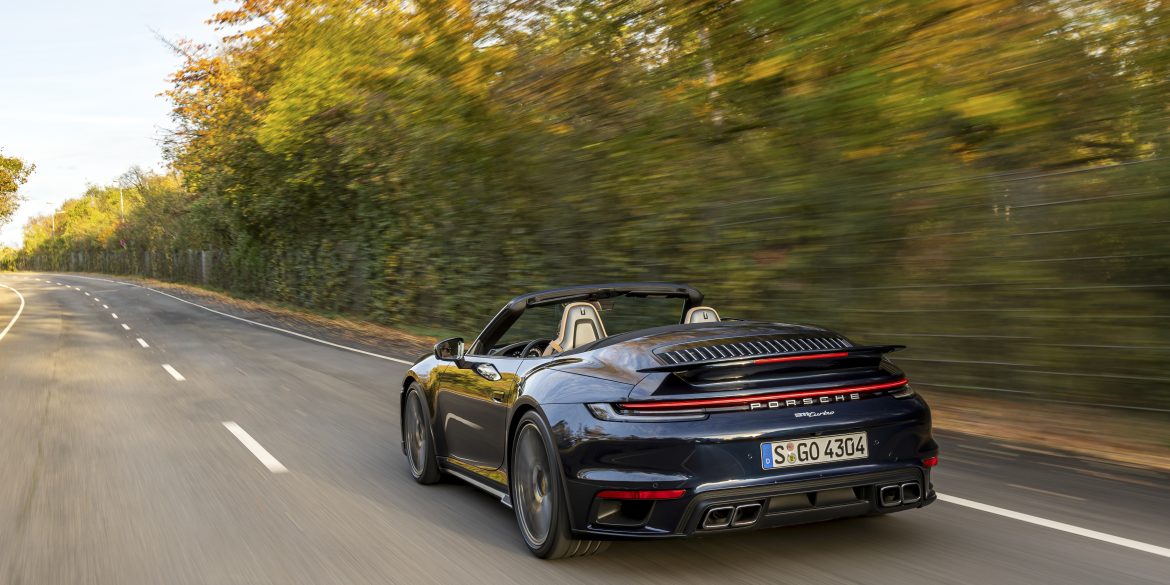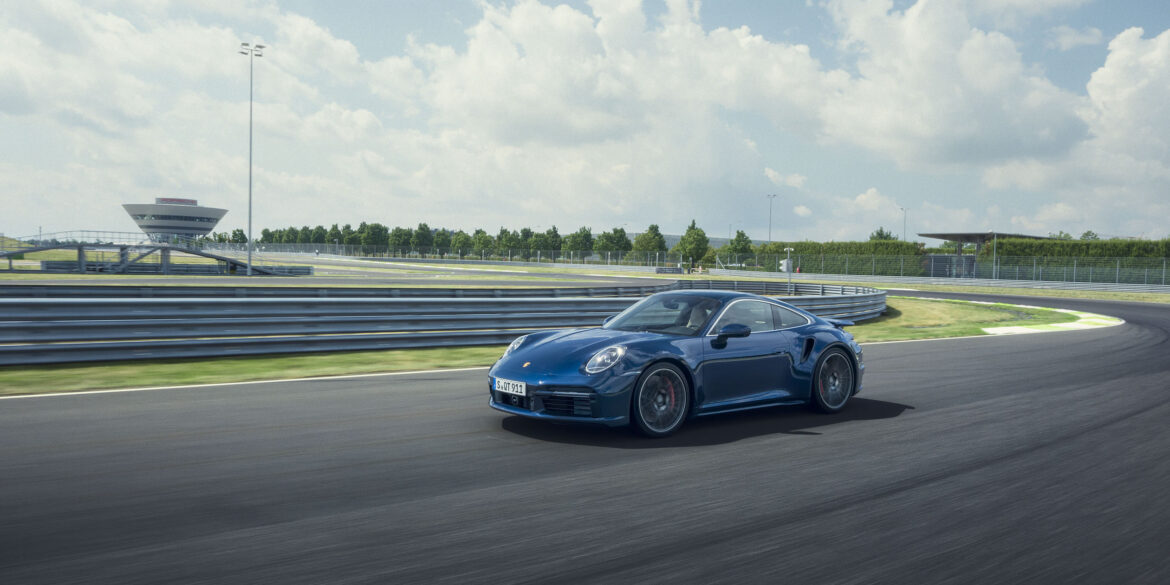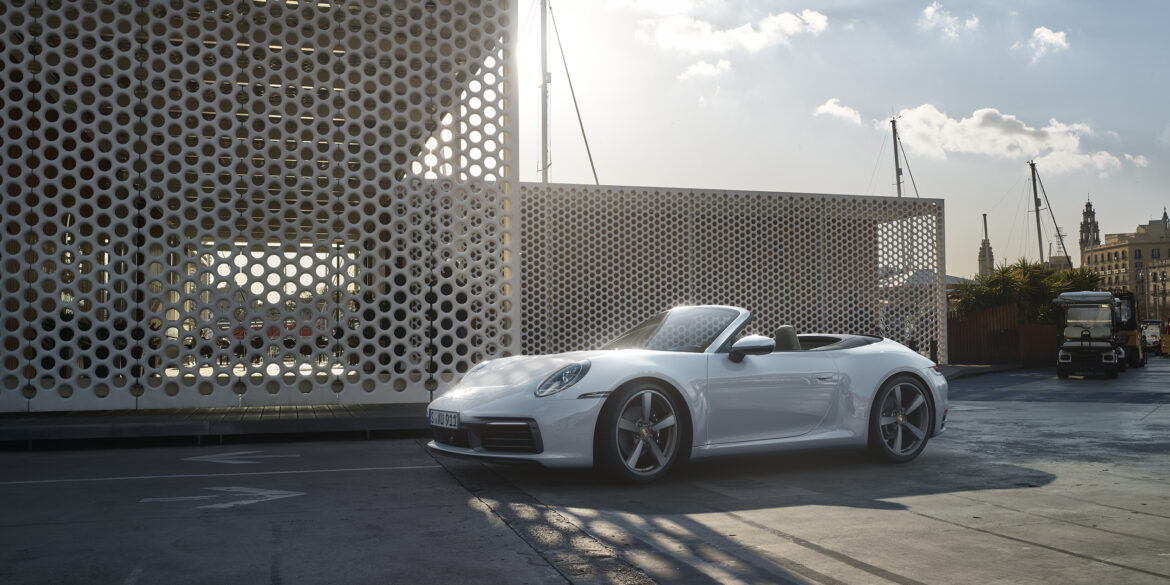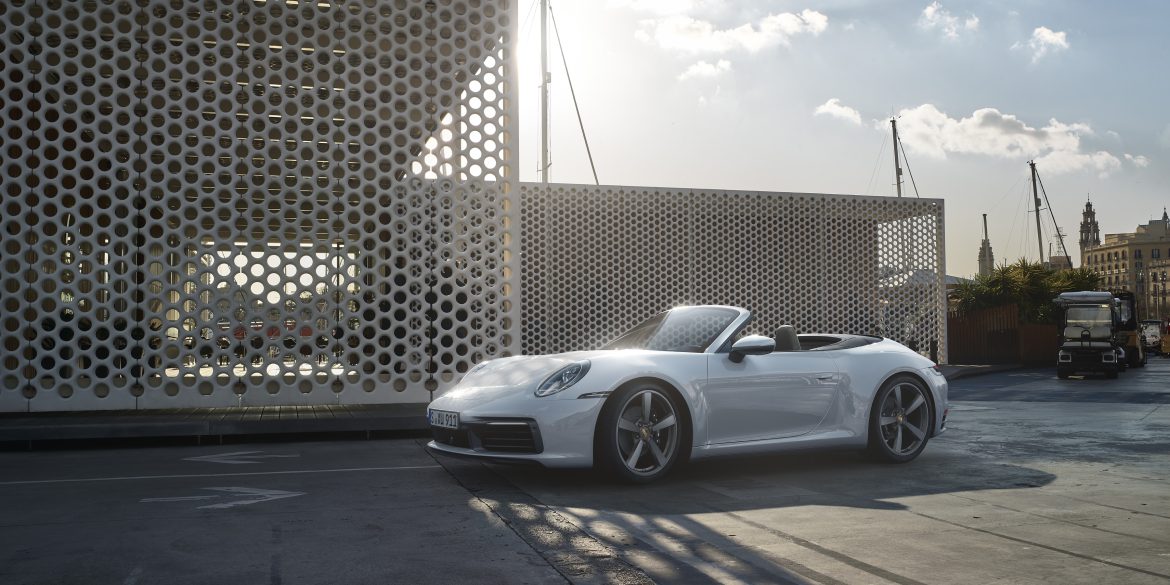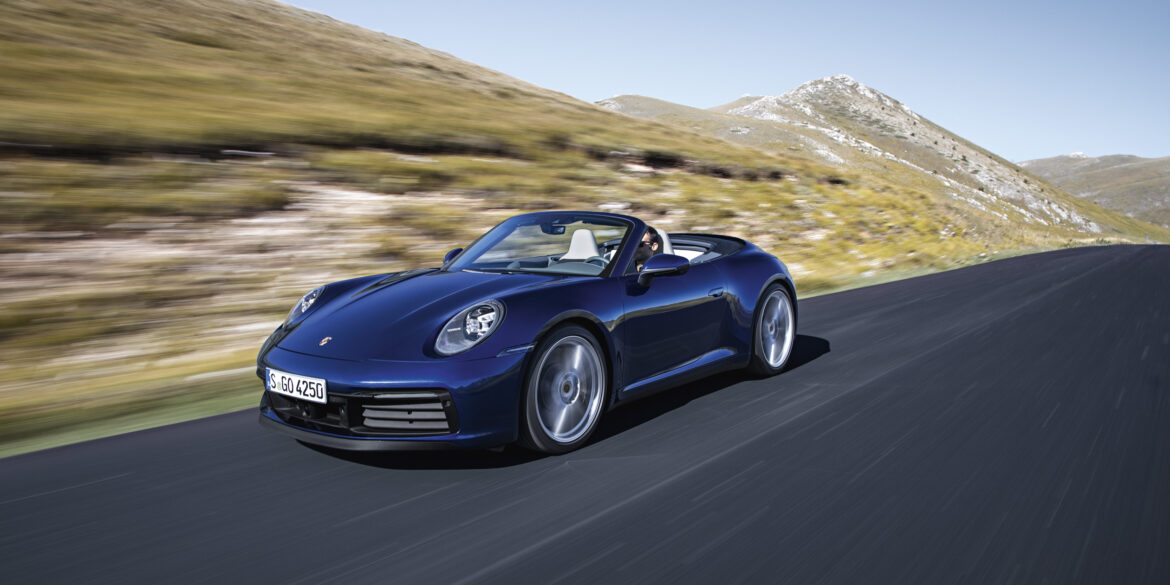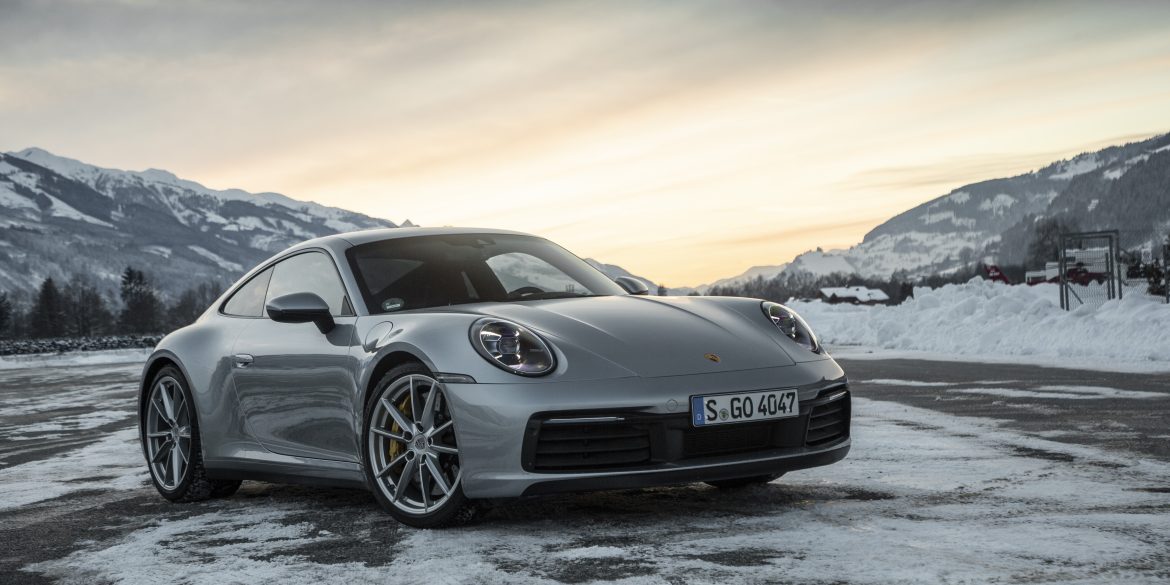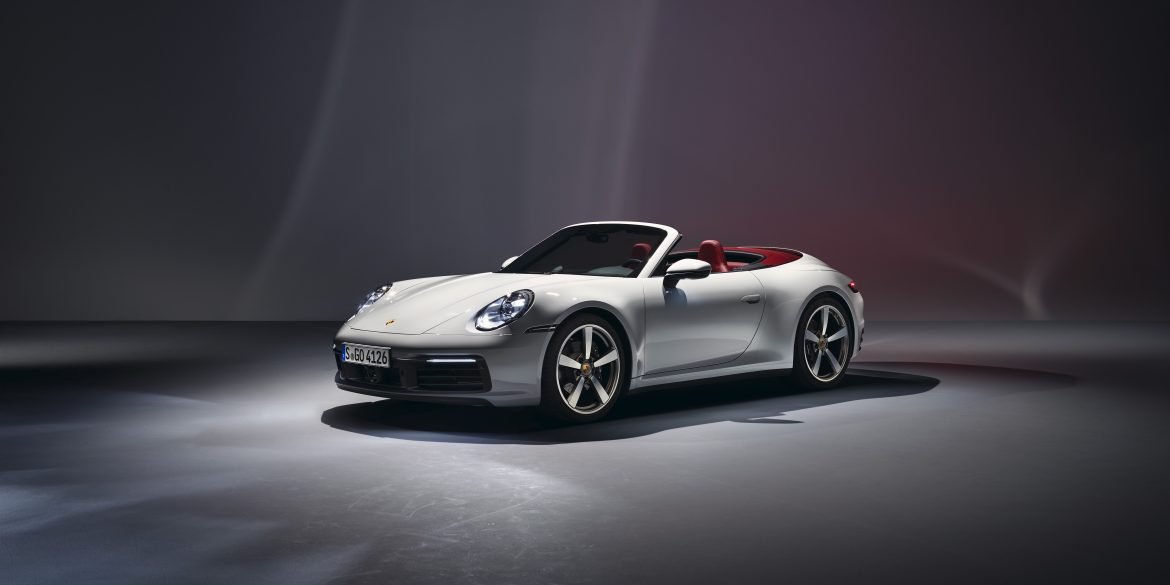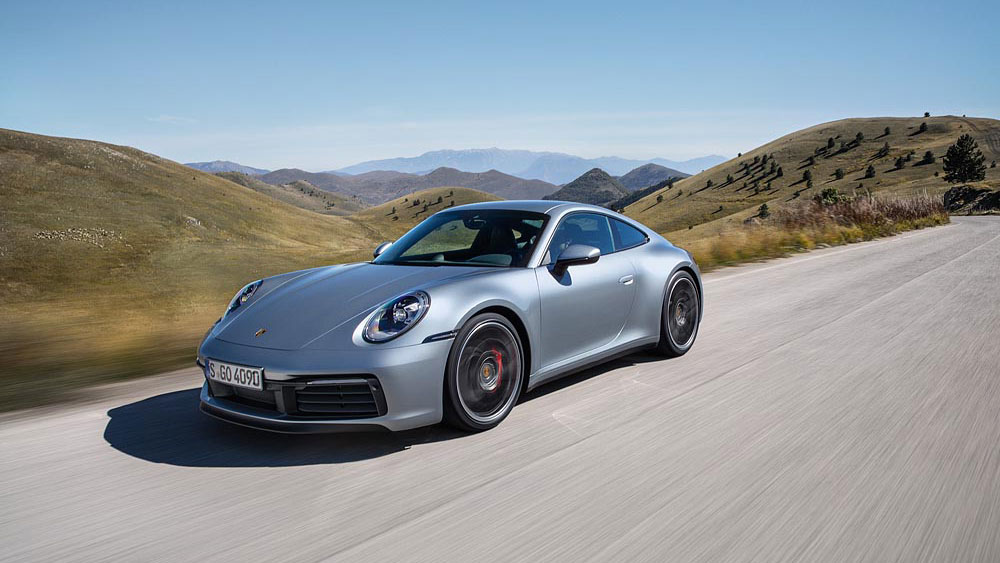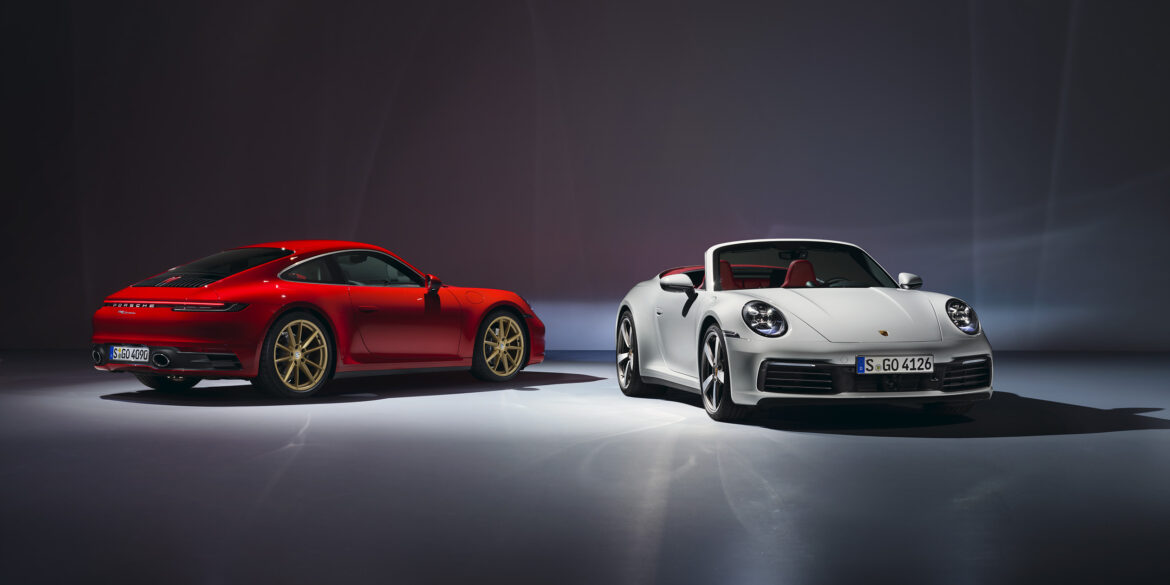At its core: a 4.2-liter naturally aspirated flat-six engine, delivering up to 565 PS (416 kW), depending on BoP. The six-speed sequential dog-type gearbox ensures fast, aggressive shifts. New ceramic wheel bearings in the rear, improved driveshaft cooling via NACA ducts, and enhanced steering fluid cooling all contribute to long-term durability. Enhanced functions on the steering wheel and improved cockpit ventilation make the 911 GT3 R a place to perform for any driver.
Lightweight and focused, the Carrera T Coupe (992.2) revives the “Touring” ethos with driver-oriented purity and a manual gearbox option. It strips away excess for those who crave connection over comfort. If you want the purest manual experience in the modern, non-GT 911 lineup, the 992.2 Carrera T is where you should start.
The Carrera T Cabriolet (992.2) pairs minimalist performance tuning with open-air joy. It’s a lightweight, driver-focused 911 designed for those who want engagement with a breeze. If you want the purest manual experience in the modern, non-GT 911 lineup, the 992.2 Carrera T is where you should start and with the top off, it is nearly perfect.
The Carrera 4 GTS T-Hybrid Cabriolet (992.2) combines the all-weather confidence of AWD with hybrid-boosted performance and open-top emotion. It’s the ultimate grand-touring expression of Porsche’s next-gen technology.
The open-top GTS T-Hybrid Cabriolet (992.2) delivers hybrid-enhanced power and effortless speed with roof-down exhilaration. It’s the pinnacle of modern 911 performance and luxury blended into one package.
Offering the same boosted power and precision as the Coupe, the Carrera S Cabriolet (992.2) adds open-air exhilaration to its 443-plus-horsepower punch. It’s equally suited to coastal cruises and spirited backroad drives.
The Carrera 4S Coupe (992.2) adds Porsche’s all-wheel-drive stability and traction to the S’s enhanced performance package. It’s a confident, year-round performer that blends all-weather usability with razor-sharp handling.
The 911 Carrera Coupe (992.2) is the entry point to the 992.2 lineup, pairing classic rear-engine balance with a refined twin-turbo flat-six and modern hybrid-ready chassis updates. It delivers pure, analog-feeling performance with the everyday usability that defines the 911 formula.
Blending open-air driving with the same precision dynamics as the Coupe, the Carrera Cabriolet (992.2) features a lightweight soft-top and a balanced, responsive twin-turbo flat-six. It’s the quintessential everyday sports car with an added sense of freedom and drama.
Marrying all-wheel drive and open-top excitement, the Carrera 4S Cabriolet (992.2) is both fast and composed in any condition. It delivers grand-touring comfort with unmistakable 911 performance DNA.
The Carrera S Coupe (992.2) steps up performance with more power, sharper handling, and enhanced driver engagement. It’s the sweet spot between daily comfort and true 911 excitement for purists who want the edge without excess.
Fusing the Targa’s timeless roofline with hybrid innovation, the Targa 4 GTS T-Hybrid (992.2) is the most advanced and desirable Targa ever built. It balances nostalgia, all-wheel drive, and cutting-edge performance.
The Targa 4S (992.2) combines the all-wheel-drive capability of the 4S with an iconic, semi-open glass roof design. It’s a nostalgic yet thoroughly modern 911 aimed at those who value both style and substance.
Adding all-wheel-drive precision to the new hybrid GTS platform, the Carrera 4 GTS T-Hybrid Coupe (992.2) offers relentless traction and electrified acceleration. It’s a cutting-edge grand tourer with unmistakable 911 heritage.
The GT3 (992.2) remains Porsche’s purist masterpiece, powered by a naturally aspirated flat-six that screams past 9,000 rpm. It’s a motorsport-bred track weapon refined for the open road. For the first time for a GT3, a Weissach Package option is available. This will include different, lightweight wheels, an alcantara dash option with chrono, and exposed carbon fiber touches in the cabin.
It features Porsche’s latest electrically augmented powertrain, dubbed the T-Hybrid. In recent history, the Carrera GTS has come to represent an ideal middle-ground within the 911 roster, where performance, versatility, and price all converge at an agreed upon sweet spot. “When you look at the hybrid characteristics, it is a perfect fit for the GTS.”
The return of the Touring badge, now on the Type 992. In a way, the car may seem sparingly equipped, and apart from the paint color, the wheels, and if you want a 7-speed manual or 8-speed PDK, it is. But it’s what it’s equipped with that makes the Porsche drivers smile. The purist-focused Carrera T is perfectly specced for fun, with its sweet rear-wheel drive, no rear seats, and a manual gearbox for just $118,050.
The 992 Porsche Targa 4 GTS adds more grunt, packs less weight, has sharper handling, and packages it up in the sexiest bodystyle that Porsche sells. The Targa 4 GTS gives us the best of all worlds, providing all-wheel-drive traction, an open-top experience, and a fixed-roof feeling in the same car. Its automatic transmission and adaptive suspension completed the image of a daily-driver sports car. This may be the perfect car.
Porsche has also decided to gift the GTS a more distinct and dynamic personality that can’t be duplicated via the Carrera S’s options list (even if you could get the engine, which you cannot). The downside is that the price has gone up too and ticking a few more options boxes can get the Carrera 4 GTS Cabriolet into 911 Turbo territory price-wise. In the engine department, the 3-litre twin turbo flat six develop 473 bhp and 420 ft lbs.
The engine is the same 3.0-litre, twin-turbocharged flat-six petrol engine as in the 911 Carrera S, but it has been fettled to produce 473 bhp. The GTS also has a bespoke suspension set-up that sits 10mm lower than the standard 911, and that's true no matter whether you choose two- or four-wheel drive. Most of the time, there's absolutely no difference between the standard GTS and the all-wheel-drive version. But when you need it, the AWD Carrera 4 GTS will save you.
The 992.1 Porsche 911 Carrera GTS Cabriolet arrives with 473 horsepower and 420 ft lbs of torque. Porsche's ultimate Carrera cabriolet model is brilliant, and flexible. Sure, you can go faster in a 992 911 Turbo, but we guarantee it won't be as much fun or as engaging as the GTS Cabriolet. This is just a great car, an all-round sports car that combines effortless performance with open top fun. It gets a 3.0-liter twin-turbocharged flat-six engine producing 473 horsepower.
The reality was that in the past you could basically build your own GTS. In the past, Porsche offered an optional factory "power kit" for 911 Carreras, but things are different now. That isn't an option for the 992. The 992 Porsche 911 Carrera GTS is therefore your only pass for accessing a version of the 3.0-liter twin-turbo flat-six tuned up to 473 hp and 420 ft lbs of torque. Those figures are achieved via an approximately 14.5 percent increase in turbo boost pressure.
Like the standard 4S, the Targa 4S produces 443 bhp @ 6500 rpm from a six-cylinder, 3.0-litre boxer engine with twin turbochargers, and puts it to the road via an eight-speed PDK and Stuttgart's refined all-wheel-drive system. 390 ft lbs from as low as 2300 rpm also means you have tons of mid-range power on tap for any situation. Compared to the previous generation Targa 4S, the new model is up 23 hp and 22 ft lbs of torque.
While the base Targa isn't the most dynamic 911, it will suit a certain buyer well. If you want the sexiest looking 911 that is a great all-rounder and you don't plan on spanking it all the time, then this is a great 911 to buy. Even in lower-powered form, the 3.0-liter is a peach of an engine. Torquey across its rev range, it responds quickly to prods of the throttle. The real problem with the Targa is the added weight and the structure, which hurts it dynamically.
All Porsche 911s are turbocharged these days but the Turbo model is something special. It gets the twin-turbo 3.7-liter flat six with tons of power and a huge $33,000 savings over the Turbo S. Thanks to an output of 573 hp, marking an increase of 32 hp over the predecessor, the new 911 Turbo Cabriolet accelerates from 0 to 60 mph in 2.8 seconds (0.2 seconds faster than before). The Turbo Cabriolet basically handles like a coupe.
It would be a disservice to call this new Turbo a "lesser" car than the Turbo S, but it does have less in most departments. Less power at 573 HP. Less features compared to the jam-packed Turbo S. Most importantly, less money required to put one in your garage. This also is not to say that the new Turbo isn't anything short of a monster. It will still go 0 to 60 in 2.8 seconds, will corner like it was on rails with Porsche Torque Management (PTM) all-wheel-drive.
Features like Porsche’s active suspension and the new-for-992 “wet mode” are standard on the Carrera 4 variants, but the electronically controlled limited slip rear differential (standard on the 4S), as well as ceramic composite brakes (cast iron rotors are standard). The current 911 Carrera 4 Cabriolet is equipped with PASM (Porsche Active Suspension Management). The twin-turbo flat-six has 379 hp and 331 ft lbs of torque.
The Carrera 4 is the base model 911, equipped with all-wheel drive. It starts at $109,850 for 2022, which is about $7,000 more than the standard rear-drive Carrera. Other than the additional all-wheel-drive system and the 150 odd pound increase in curb weight, the Carrera 4 is identical to its rear-drive sibling. It gets the same 379-hp, twin-turbo 3.0-liter flat-six engine. The twin-turbocharged 3.0-liter flat-six has 379 hp.
Top down summertime driving in the current 911 Carrera 4S Cabriolet is about as good as it gets. It checks all of the right boxes, as while it has matured into almost a GT-type car; it still boasts more performance than ever. Like the rest of Carrera S models, the Carrera 4S Cabriolet is powered by the same 3.0-liter twin-turbo flat-six that makes 443 horsepower and 390 ft lbs of torque. It comes standard with the same eight-speed twin-clutch automatic transmission.
The perfect daily driving sports car with an all-weather, remarkably high-performance envelope. Like the rest of Carrera S models, the Carrera 4S is powered by the same 3.0-liter twin-turbo flat-six that makes 443 horsepower and 390 lb-ft of torque. It also comes standard with the same eight-speed twin-clutch automatic transmission with the same gear ratios, except the 4S with an added clutch and differential up front.
The Porsche 911 Carrera S Cabriolet also features a heated glass rear window and integrated magnesium support elements. The automatic fabric top opens and closes at speeds of up to 31 miles per hour in just 12 seconds – one second quicker than before. The 992 Carrera S Cabriolet gets a twin-turbo 3.0-liter flat-six with 443 bhp and 390 ft lbs of torque. That is 29 more horsepower and 22 more ft lbs of torque than the outgoing model.
If the base 911 coupe doesn't do it for you, maybe the Carrera S coupe gets you over the line. For about $20k more, you get more horsepower, torque vectoring and bigger wheels. The Carrera S uses a version of the 3.0L twin-turbo flat-6 that generates 443 hp and 390 lb-ft of torque. Torque vectoring allows different amounts of torque to be distributed between drive wheels on the same axle. This means the inside wheel can turn slower than the outside wheel for improved cornering.
Removing the roof the car is supposed to have little impact on its chassis stiffness and curvy road prowess, but Porsche tells us that the current generation 911 Cabriolet drives just as well as the coupe. Powering the base Cabriolet is the same impressive turbocharged flat-six engine that makes 379 bhp @ 6500 rpm and 331 ft lbs of torque. The base cabriolet can do the 0 to 60 mph run in 4.2 seconds flat. With the optional Sport Chrono Package that drops to 4.0 seconds.
The most basic version of the Porsche 911 Carrera is pretty sweet. Porsche chose to detune the twin-turbocharged flat-six engine and downgrade some of the chassis components. These cars offer very good performance and driving dynamics for a slightly lower price. While marginally larger and heavier than the 991-generation model it replaced, the 992 is also more advanced. Power climbs by 15 bhp from the 991 Carrera, to 379 bhp @ 6500 rpm, which is more than enough horsepower for the street.


